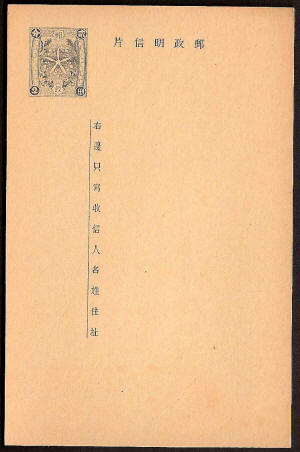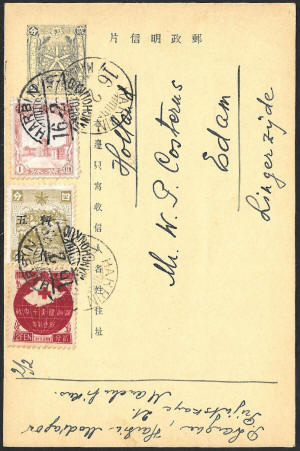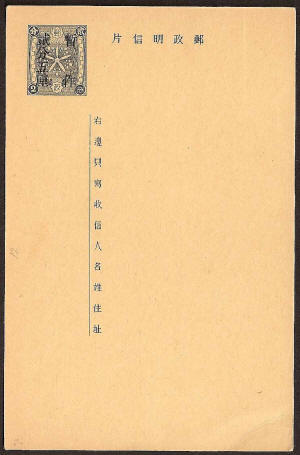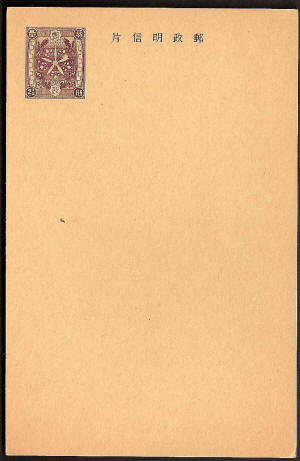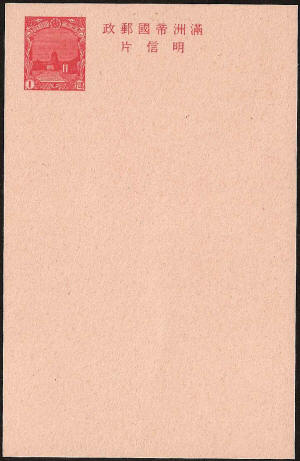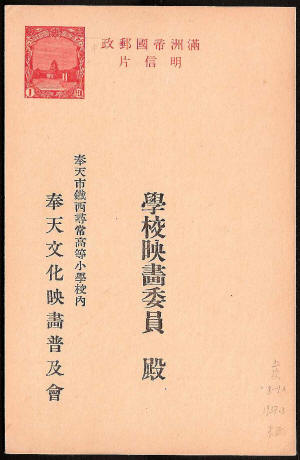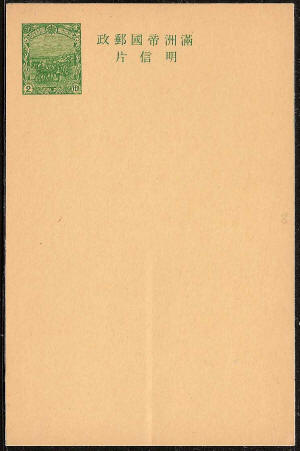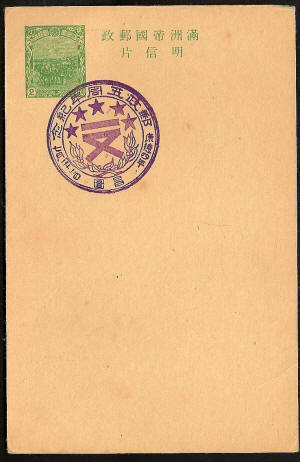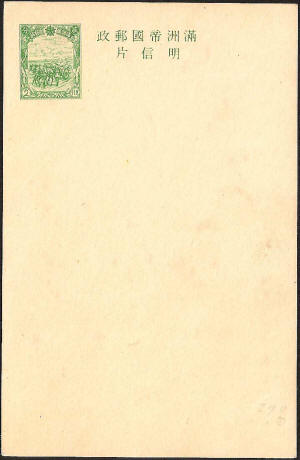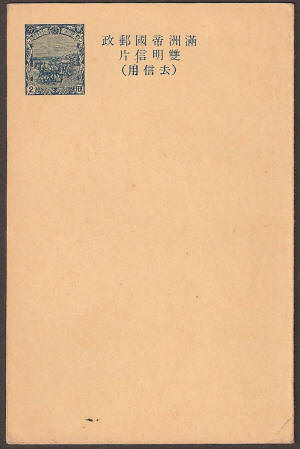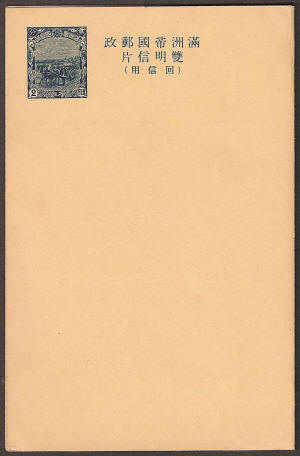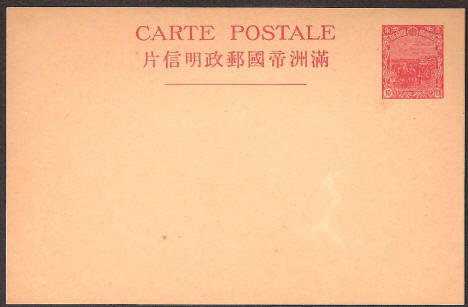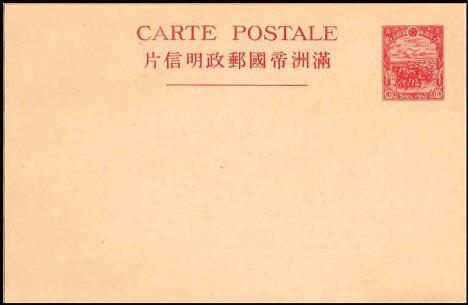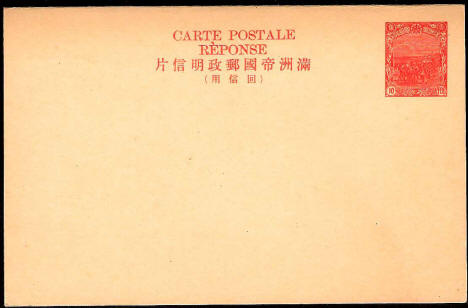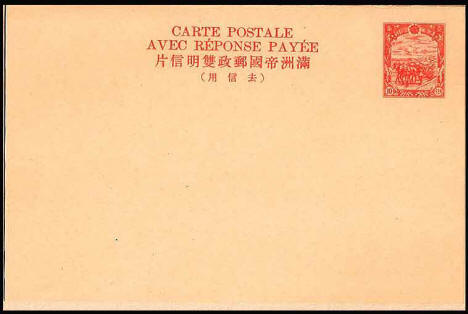 |
|||||
|
Pre-Stamped Postcards Imprinted Postcards 1932 to 1934 Imprinted Postcards 1935 to 193 9Imprinted Postcards 1940 to 1950 Post Office Issued Picture Post Cards Abolition of Extraterritorial Rights
|
|||||
|
Postcards 1935 to 1938 1935 - 1939 China Mail Postcards A new 2f postcard was produced as a result of the Sino-Manchukuo postal agreement of December 1934. This was based upon the First China Mail stamp design and as a result cards sent to China would not be subjected to additional postage due charges, as had previously been the case. Importantly, the new cards did not include "Manchu Empire" in the heading, the remaining five characters simply read "Postal Service, Post Card". On 1st April 1937 remaining stocks of the 2f stamp were overprinted with a surcharge changing the value to 2½f and a new 2½f postcard produced as a result of a price increase. 1st January 1935 2f Postcard, this could be used domestically within Manchukuo, for post to Japan and also for mail to China. The imprinted stamp is based upon the design of the new China Mail 2f postage stamp the only difference being colour, the 2f China mail stamp is sage green. This card appears in two varieties, with the five horizontal characters within 7mm to 9mm of the imprinted stamp, or within 10mm to 12mm of the imprinted stamp. The above example is of the narrower setting. This is a 2f domestic postcard up-rated for international use for sending to Holland with the addition of stamps worth 8f. 10f was the correct rate when the card entered the post at Harbin on 16th February 1939 (as shown by the international date-stamps). |
|||||
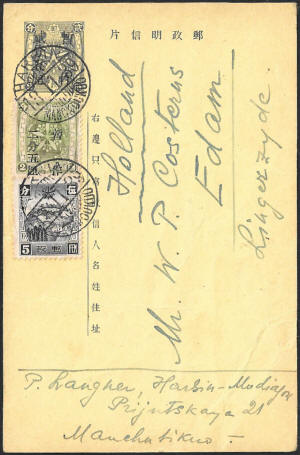 |
|||||
|
1st April 1937 1935 2f China Mail Postcard with a surcharge showing the new rate of 2½f. |
This card has the indicia changed from 2f to 2½f, the same thing has happed to the stamp below so with the addition of the 5f stamp the total postage applied is 10f. This is the correct postage for a card sent from Harbin to Holland on 13th November 1939. . | ||||
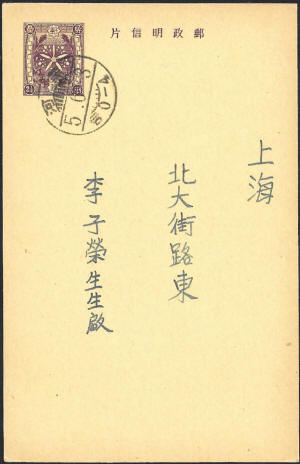 |
|||||
|
1st April 1937 2½f China Mail Postcard, the colour now matched that of the 2½f China Mail postage stamp. Cards produced in 1937 were printed on cream stock in 1938 this was changed to buff. Toning and dirt gathered over the last 70 years makes the true colour of the card hard to distinguish. |
This is an example of the card fulfilling it main function. The card was sent from 黒河 Heiho in Manchukuo on 3rd June 1938 to 上海 Shanghai in China. . | ||||
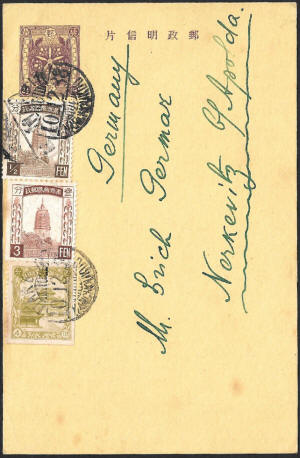 |
|||||
| This 2½f card has an additional 7½f of postage stamps added for international use to Germany. 10f is the correct rate for a card sent from Harbin to Germany on 10th December 1938. . | |||||
|
|
|||||
|
Fourth Regular Issue Postcards 1936 to 1944. On the 4th December 1936 Manchukuo launched the Fourth Regular Issue of postage stamps, all with a scenic theme. This prompted the postal administration to re-design existing postcards based upon the new set of definitive stamps. The first cards to appear, either late December 1936 or early January 1937, were the 6f and the 6f x 6f for use on foreign mail, this was based upon the "Farmers Carting Soya Beans" design. Another price increase took place on 1st April 1937 and this meant that these cards were only in use for four months. It appears that unused stock was recalled and destroyed, making these cards quite difficult to find. The complete "fourth Regular Issue" set of postcards was released on 1st April 1937 but the "Farmers Carting Soya Beans" design may have been considered unsatisfactory. The very heavy use of parallel lines made the design look clumsy compared to the stamps with dies engraved by Kikuji Nakata. After the initial stocks of this card had been sent out they were redrawn, presumably by a different engraver. The new design has a lighter sky, with well defined clouds and a single line frame around the imprinted stamp, the finished look is much closer to that of the "fourth Regular Issue" postage stamps. Redrawn stamps went on sale during November 1937.
|
|||||
|
|
|
||||
|
1st April 1937 1f Postcard (Type 1) for local post only, there are three types of this card and they seem to have been discontinued at the end of this year. In this example the top of the left hand character "政" lines up with the top edge of the "洲" character of the imprinted stamp. |
1st April 1937 Used 1f Postcard (Type 2). In this example the bottom of the left hand character "政" lines up with the top edge of the "洲" character of the imprinted stamp. This version is the hardest to find. | ||||
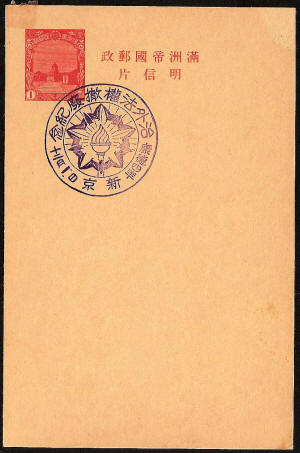 |
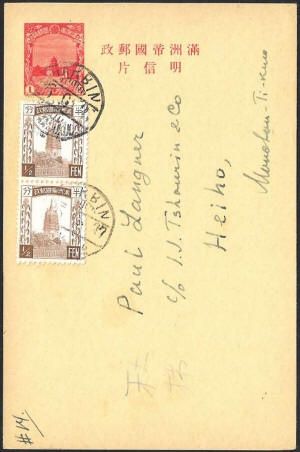 |
||||
| 1st April 1937 C.T.O. 1f Postcard (Type 3) with (Zirkle 37), commemorative cancellation (1-3 December 1937). In this example the character "政" is well below the "洲" character of the imprinted stamp and instead lines up with the top of the scroll decoration. The 1f local rate for postcards was discontinued on 16th November 1940. | This is an example of the (Type 3) 1f local postcard up-rated to 2f for domestic use. In this instance for sending a message from Harbin to 黒河 Heiho. The dater reads 25th September 1937. . | ||||
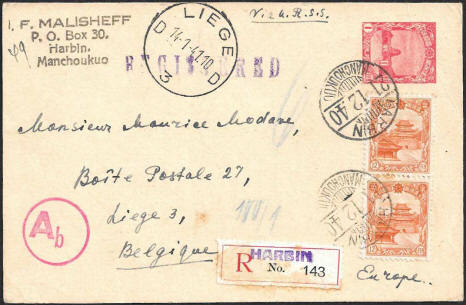 This is a 1f local card used by the well known Harbin stamp dealer Ivan Fedorovitz Malicheff for sending a message to a customer in Belgium. It should be noted that this card carries the wrong postage rate leaving it under paid by 1f. In December 1940 the international postcard rate was 10f and registration an extra 16f; this apparently did not stop it from reaching Belgium as you can see from the Liege date-stamp. . |
|||||
 |
 |
||||
|
June
1938 1f
+ 1f Postcard. Note the chocolate colour of the imprinted stamp.
This shows a "sky of lines" design, which is the only type known. Dr
Spaulding lists two further colour variations. In brackets we have
(用信去) meaning a letter to and (用信回) a letter back
(the reply section).
This is a 1f x 1f local rate reply postcard up-rated by 1f so that it could be used for sending to other towns, in other words for domestic use. In this instance we have the reply section returned to Mr P. Langner in 黒河 Heiho. The cover entered the post in (as far as I can make out) 掖河 Yeh-he on 4th November 1937, the postal rate is correct for this time. |
|||||
|
1st April 1937 2f Postcard (Type 1). In this example the bottom three characters in the heading line up with the centre of the imprinted stamp. The sky is heavily lined and there is an error in the drawing of the "2" character, with two lines above the usual top line. |
July 1937 Used 2f Postcard (Type 2) with (Zirkle 32), commemorative cancellation (26-28th July 1937). In this example the top of the left hand character "政" lines up with centre of the orchid crest of the imprinted stamp. The sky is heavily lined. "2" character error corrected. |
||||
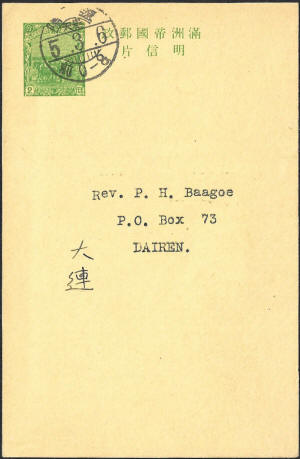 |
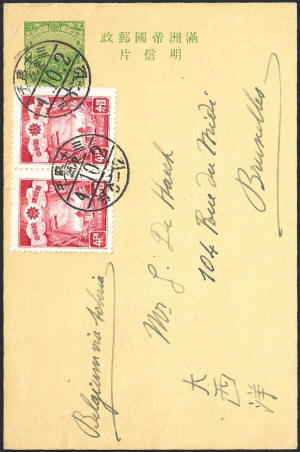 |
||||
| This (Sky of Lines -Type 1) card was sent to Dairen from 遼陽 Liao-yang on 6th March 1938. Mail to Dairen was charged at the same price as domestic mail and the 2f fee is correct for this time. | This (Sky of Lines -Type 1) card was sent to Belgium from 三十家子 Shan-shih-chia-tzu (in Jehol) on 2nd October 1937. The card needed to be up-rated from 2f to 10f, this was done with the addition of 2 x 4f stamps. | ||||
|
|
|
||||
|
November 1937 2f Postcard (redrawn) and on cream card. This example has light clouds in the sky and several other differences from the earlier 2f two cards shown. |
April 1938 2f Postcard (redrawn) and on buff card. It seems that the postal administration changed the supplier of card around April 1938, the change in colour and quality is quite noticeable. The 10f postcards remained on the higher quality cream card. |
||||
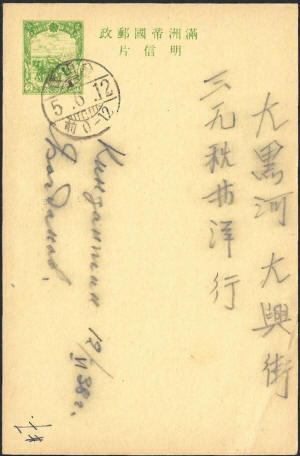 |
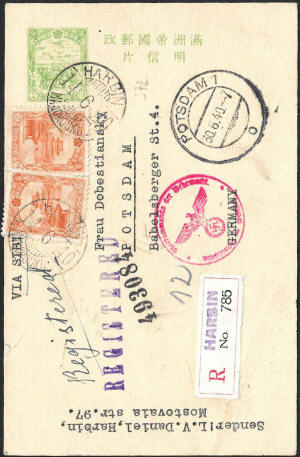 |
||||
| This 2f domestic (sky of clouds) postcard was sent from 金山鎭 Chin-shan-chen to 黒河 Heiho on 12th June 1938. The 2f card carries the correct postage for this time. | This 2f domestic (sky of clouds) postcard was sent from Harbin to Potsdam in Germany on 5th June 1940. The extra postage for international use represents 10f card rate a 16f registration fee. This was accounted for by the two additional 12f stamps. | ||||
| 1st April 1937 2f + 2f Reply Paid Domestic Rate Postcard, above is the early "Sky of lines" first issue on cream card. It is probable that the change from green to blue, for the 2f imprinted stamps, came about to make it easy for postal workers to distinguish this card from the normal 2f, when selling. | |||||
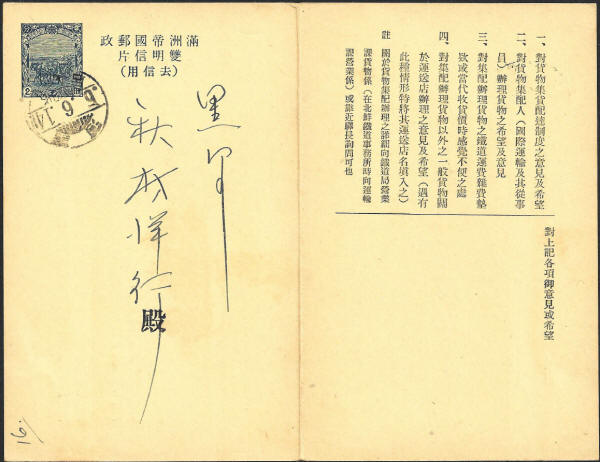 |
|||||
| This is a commercial example of domestic 2f x 2f reply card (sky of lines type) sent from 黒河 Heiho to Harbin on 14th June 1938. The postage is correct for the time of posting. The reverse of this card can be seen here. | |||||
| 1st May 1938 Above is the redrawn version the, so called "Sky of clouds" edition on buff card, available from May 1938 and is on buff card. A similar version on cream card came into use in February 1938, the buff card shown above replaced this. | |||||
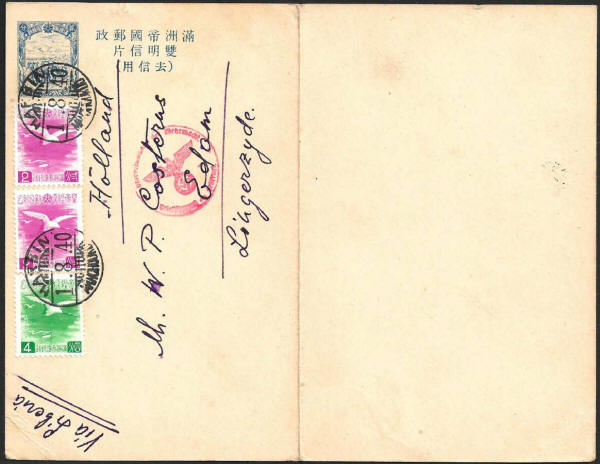 |
|||||
| 2f x 2f (Sky of clouds type) reply card, in this instance sent to a stamp dealer in Holland. The card entered the post in Harbin on 1st August 1940 and, as we can see from the eagle and swastika marking, it passed through Germany. Both sides of the card needed additional stamps to make up the total reply cost of 10f each way. You can see the reverse of this card here. It had no additional stamps so perhaps this is why it was never returned. | |||||
 |
|||||
| 2f Reply card (Sky of lines - reply section) returned from 三重 Kyōto, Japan on 5th October 1942. The cost of sending reply card increased in March 1942 from 2f to 3f which is why the addition of the two ½f stamps were needed. These would have been applied by the original sender. | |||||
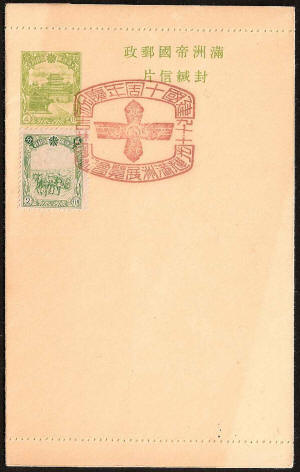 |
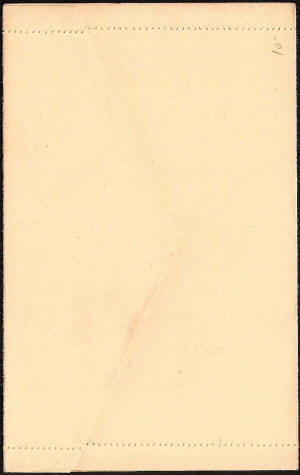 |
||||
|
1st April 1937 4f Imprinted Letter-sheet (also known as a sealed post card - face and reverse shown above), these were in use from April 1937 and continued in an up-rated form until the fall of Manchukuo in 1945. The above example can be dated by the commemorative cancellation to 17th or 18th May 1942 (Zirkle 62), by which time the additional 2f stamp was required. Letter-sheets measure 90mm x 140mm folded and 320mm x 140mm when opened. There are two distinct varieties of letter-sheet, the above with the horizontal characters (reading - top 6 "Manchu Empire Postal Service", bottom 4, "Sealed Post Card") aligning slightly above the top of the imprinted stamp, (as in this example), or aligning slightly below. There are also stamp colour variations. In October 1944 the paper colour was changed from cream to white, these later examples are hard to find. |
|||||
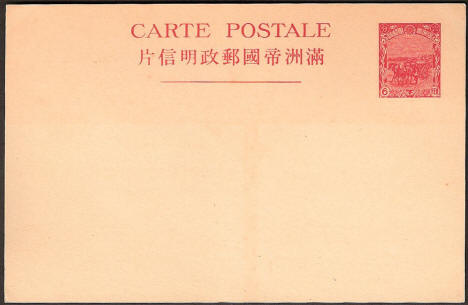 |
|||||
| December 1936 6f Postcard. This imprinted card is of the "sky of lines" type, the only version to be produced. Prices for international mail increased on 1st April 1937 to 10f quickly rendering these cards obsolete and as a result they are hard to find. There is also a 6f + 6f card available. Both cards are printed on good quality, smooth cream card. | |||||
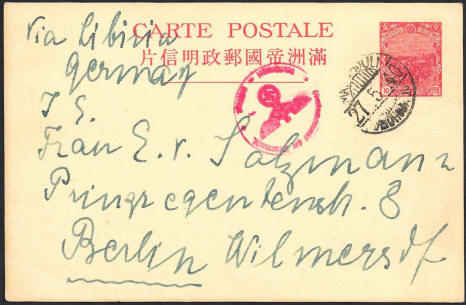 |
|||||
| This card 10f international (Sky of lines type on cream card) has been used as intended and sent from 滿洲里Manchouli to Berlin on 27th May 1940 | |||||
|
1st April 1937 10f Postcard for all overseas destinations, excluding Japan and China, early version with the "Sky of lines", later redrawn - see below.. It is curious that the 10f Imprinted stamp is a red version of "Farmers Carting Soya Beans" and not as in the 1936 fourth Regular Issue, the "Summer Palace at Chengteh" - why the change? April/May 1938 10f Postcard on cream card, redrawn version with sky of clouds. A further "sky of clouds" design on white card was issued in May of 1943 and is very rare. 1st April 1937 10f + 10f Reply Paid Postcard, above are both parts of this card, the top copy is for use by the sender and below the reply section used by the recipient. The horizontal characters read "Manchu Empire Postal Service Reply Paid Card", the alternative French wording is in error, a grave accent appears in place of the acute accent "è", this was corrected in later issues. This card is something of a rarity and sought after by collectors. April 1938 This is a redrawn version of the above card with the "Sky of Clouds" design on cream card. Note the corrected accent "é" above the E. A further issue on white card might have been in May 1943, but is also possible that this card was not issued and the small number known come from stock looted by the Russian military from the vaults of Hsinking Post Office at the end of the war.
Sources of the information used in this page - The first person to write definitively (in English) about the Imprinted Postcards of Manchukuo was Dr. Robert M. Spaulding Jr., his "The Catalogue of Postal Stationary of the Japanese Occupation of China, Part One, Manchuria", forms the core of Western knowledge of this subject and was the basis of the Higgins & Gage section on Manchukuo. I have found both works very helpful in compiling this page. Other references include the JSCA Japanese Stamp Specialized Catalogue Vol. 3 and articles from "The China Clipper", the journal of the China Stamp Society. |
|||||
